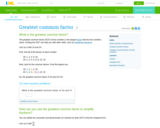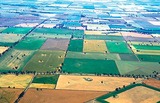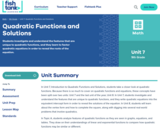
Students will learn how to find the Greatest Common Factor of two or more numbers by using math manipulatives.
- Subject:
- Mathematics
- Material Type:
- Lesson Plan
- Provider:
- BetterLesson
- Date Added:
- 12/01/2022

Students will learn how to find the Greatest Common Factor of two or more numbers by using math manipulatives.

Practicing math problems is a great way to study for a math test!

Students collaborate on a greatest common factor and least common multiple project.

Students further their understanding of finding the greatest common factor and least common multiples.

Students show what they know about greatest common factor and east common multiple.

When would you come across GCF and LCM? Students apply their knowledge of GCF and LCM to solve word problems.

Students differentiate between greatest common factor and least common multiple word problems.

In this video, learn how to find the greatest common factor of two numbers. Then, see how this can be used to solve problems with large numbers. In the accompanying classroom activity, students learn to find prime factors using factor trees. They then learn how prime factors, a Venn diagram, and simple multiplication can help them find the greatest common factor of two numbers. The lesson challenges students to find the greatest common factor of increasingly large numbers. It also pushes them to think about how prime factors are the building blocks of composite numbers.

Clearly understand the difference between factors and multiples builds a foundation for applications and problem solving using GCF and LCM.

Brush up on your math skills relating to the greatest common factor then try some practice problems to test your understanding.


Expressions
Type of Unit: Concept
Prior Knowledge
Students should be able to:
Write and evaluate simple expressions that record calculations with numbers.
Use parentheses, brackets, or braces in numerical expressions and evaluate expressions with these symbols.
Interpret numerical expressions without evaluating them.
Lesson Flow
Students learn to write and evaluate numerical expressions involving the four basic arithmetic operations and whole-number exponents. In specific contexts, they create and interpret numerical expressions and evaluate them. Then students move on to algebraic expressions, in which letters stand for numbers. In specific contexts, students simplify algebraic expressions and evaluate them for given values of the variables. Students learn about and use the vocabulary of algebraic expressions. Then they identify equivalent expressions and apply properties of operations, such as the distributive property, to generate equivalent expressions. Finally, students use geometric models to explore greatest common factors and least common multiples.

Lesson OverviewStudents use a geometric model to investigate common multiples and the least common multiple of two numbers.Key ConceptsA geometric model can be used to investigate common multiples. When congruent rectangular cards with whole-number lengths are arranged to form a square, the length of the square is a common multiple of the side lengths of the cards. The least common multiple is the smallest square that can be formed with those cards.For example, using six 4 × 6 rectangles, a 12 × 12 square can be formed. So, 12 is a common multiple of both 4 and 6. Since the 12 × 12 square is the smallest square that can be formed, 12 is the least common multiple of 4 and 6.Common multiples are multiples that are shared by two or more numbers. The least common multiple (LCM) is the smallest multiple shared by two or more numbers.Goals and Learning ObjectivesUse a geometric model to understand least common multiples.Find the least common multiple of two whole numbers equal to or less than 12.

Students use a geometric model to investigate common factors and the greatest common factor of two numbers.Key ConceptsA geometric model can be used to investigate common factors. When congruent squares fit exactly along the edge of a rectangular grid, the side length of the square is a factor of the side length of the rectangular grid. The greatest common factor (GCF) is the largest square that fits exactly along both the length and the width of the rectangular grid. For example, given a 6-centimeter × 8-centimeter rectangular grid, four 2-centimeter squares will fit exactly along the length without any gaps or overlaps. So, 2 is a factor of 8. Three 2-centimeter squares will fit exactly along the width, so 2 is a factor of 6. Since the 2-centimeter square is the largest square that will fit along both the length and the width exactly, 2 is the greatest common factor of 6 and 8. Common factors are all of the factors that are shared by two or more numbers.The greatest common factor is the greatest number that is a factor shared by two or more numbers.Goals and Learning ObjectivesUse a geometric model to understand greatest common factor.Find the greatest common factor of two whole numbers equal to or less than 100.

What are multiples? How do they compare with factors? Students work to answer these questions and develop an understanding of greatest common factor and least common multiple.

This Cyberchase video features Bianca who uses Venn Diagrams to make a pizza that satisfies the topping preferences of her friends.

Students investigate and understand the features that are unique to quadratic functions, and they learn to factor quadratic equations in order to reveal the roots of the equation.

This lesson brings all the pieces together to have students show the how's and why's by using GCF,LCM, Distributive property and dividing fractions.

Find a quick, concise explanation of how to find the greatest common factor. Examples are given and clearly explained.

Heres a comprehensive review of the basics of algebra. WyzAnt includes lessons on varied topics, calculators that show step-by-step solutions, and interactive worksheets for practicing and testing your skills. Just choose a topic and use Algegrahelp.coms "collection of tools created to assist students and teachers of algebra."